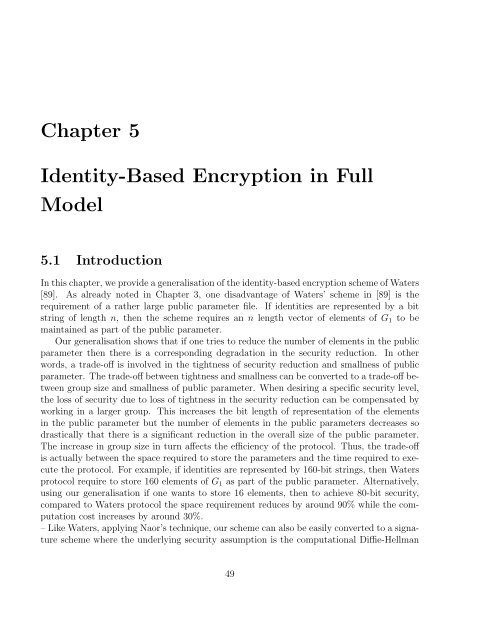Identity-Based Encryption Protocols Using Bilinear Pairing
Identity-Based Encryption Protocols Using Bilinear Pairing
Identity-Based Encryption Protocols Using Bilinear Pairing
Create successful ePaper yourself
Turn your PDF publications into a flip-book with our unique Google optimized e-Paper software.
Chapter 5<br />
<strong>Identity</strong>-<strong>Based</strong> <strong>Encryption</strong> in Full<br />
Model<br />
5.1 Introduction<br />
In this chapter, we provide a generalisation of the identity-based encryption scheme of Waters<br />
[89]. As already noted in Chapter 3, one disadvantage of Waters’ scheme in [89] is the<br />
requirement of a rather large public parameter file. If identities are represented by a bit<br />
string of length n, then the scheme requires an n length vector of elements of G 1 to be<br />
maintained as part of the public parameter.<br />
Our generalisation shows that if one tries to reduce the number of elements in the public<br />
parameter then there is a corresponding degradation in the security reduction. In other<br />
words, a trade-off is involved in the tightness of security reduction and smallness of public<br />
parameter. The trade-off between tightness and smallness can be converted to a trade-off between<br />
group size and smallness of public parameter. When desiring a specific security level,<br />
the loss of security due to loss of tightness in the security reduction can be compensated by<br />
working in a larger group. This increases the bit length of representation of the elements<br />
in the public parameter but the number of elements in the public parameters decreases so<br />
drastically that there is a significant reduction in the overall size of the public parameter.<br />
The increase in group size in turn affects the efficiency of the protocol. Thus, the trade-off<br />
is actually between the space required to store the parameters and the time required to execute<br />
the protocol. For example, if identities are represented by 160-bit strings, then Waters<br />
protocol require to store 160 elements of G 1 as part of the public parameter. Alternatively,<br />
using our generalisation if one wants to store 16 elements, then to achieve 80-bit security,<br />
compared to Waters protocol the space requirement reduces by around 90% while the computation<br />
cost increases by around 30%.<br />
– Like Waters, applying Naor’s technique, our scheme can also be easily converted to a signature<br />
scheme where the underlying security assumption is the computational Diffie-Hellman<br />
49
















